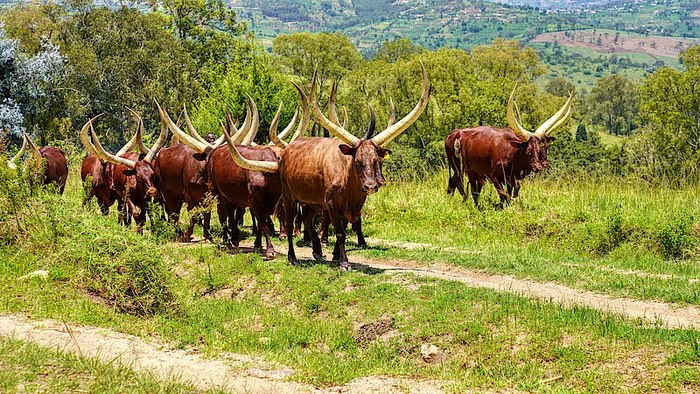
In a significant move towards transforming Rwanda’s agriculture and livestock sector, the United Nations (UN) agencies operating in Rwanda (IFAD, FAO, UNDP, WFP, One UN Women, Unicef,etc.), in collaboration with the Rwanda Agriculture and Animal Resources Development Board (RAB), are working hand in hand to support the government’s ambitious plans for food security and agricultural development. This partnership was highlighted during a recent visit by the UN agencies representatives to Semen Production Centre located in RAB/ Songa Station, where the progress of various initiatives was showcased.
The Rwanda Agriculture and Animal Resources Development Board (RAB), in partnership with those agencies, aims to improve dairy and beef cattle productivity through advanced breeding technologies and a stronger veterinary support network.
Mr. Dagmawi Habte Selassie, IFAD Country Director for Rwanda and Burundi, commended the country’s progress in livestock development. Speaking on behalf of UN agencies operating in Rwanda, he praised the government’s commitment to enhancing food security and improving livestock production.
He cited the Nyagatare Milk Powder Plant as an example of Rwanda’s efforts to strengthen the dairy industry and emphasized the importance of increasing the number of high-yield dairy breeds to sustain milk production for processing facilities. He added, “We will continue to collaborate with RAB through the IFAD grant in training and supporting veterinarians to ensure that low-income dairy farmers receive quality semen and veterinary medicines.”
In his address, Dr. Ndabamenye Télesphore, Director General of RAB, highlighted that after successfully establishing a modern Semen Production Centre, the next phase will focus on deploying veterinarians across the country to ensure timely artificial insemination services for farmers. He emphasized that this initiative is a key part of the Rwanda Dairy Development Project – Phase 2, funded by the International Fund for Agricultural Development (IFAD) and implemented under RAB.
To achieve widespread access to artificial insemination, RAB is increasing the number of veterinarians working closely with farmers, particularly in rural areas. The plan includes strengthening partnerships with veterinary clinics already operational in several districts and establishing agreements with veterinarians assigned to specific administrative cells. This will ensure that farmers receive quality services quickly and efficiently.
Dr. Ndabamenye stated, “We want the semen from here to reach farmers quickly, safely, and when they need it. We will collaborate with partners through veterinary clinics that have already been established and are now fully operational in some districts.” RAB aims to further expand this network in the next fiscal year, ensuring that trained veterinarians are available in every cell across the country.
As Rwanda continues to advance livestock breeding technologies, RAB is working on new solutions to give farmers greater control over their herds. One major innovation in the pipeline is the ability for farmers to select the sex of the calf before birth, rather than leaving it to chance. This technology will allow farmers to strategically plan their herds, focusing on milk production or beef farming as needed.
Currently, around 1,200 veterinarians have been trained in artificial insemination, and 30 high-quality bulls producing superior semen are already at Songa Station. However, RAB’s long-term goal is to increase the number of bulls to 60 as capacity expands.
With a strategic focus on innovation, accessibility, and sustainability, Rwanda is positioning itself as a leader in modern livestock farming. Through technological advancements, strengthened veterinary services, and continued partnerships with UN agencies, the country is set to transform its dairy and beef industry, ensuring higher productivity and improved food security for the future.
Information about Songa Sement Production Centre:
The revitalization of the Songa Sement Production Centre is part of a broader Rwf166 billion initiative aimed at transforming the dairy sector over the next five years.
Launched on August 30, 2024, the Rwanda Dairy Development Project – Phase 2 (RDDP 2) , funded by IFAD and implemented by RAB,will benefit 175,000 dairy farmers nationwide. The Songa Sement Production Centre is expected to play a key role in modernizing cattle breeding, ensuring a sustainable and well-structured genetic improvement system for Rwanda’s dairy industry.
With this investment, the Huye-based centre, which has been operating at minimal capacity, will integrate cutting-edge genetic technologies. These include semen and embryo production, flushing, in vitro fertilization (IVF), artificial insemination, and embryo transfer. The primary focus will be on high-yield dairy breeds such as Holstein-Friesian and Jersey, with additional options for Fleckvieh, Charolais, and Angus breeds based on demand. There is also a commitment to preserving indigenous breeds, with semen and embryos of Inyambo and Inkungu cattle being produced to support conservation efforts.
Beyond breeding advancements, the centre will also serve as a hub for dairy innovation and training. A major focus will be on animal nutrition, with investments in improved forage production, hydroponic fodder systems, and forage postharvest treatment and conservation. The introduction of irrigation and mechanized forage production will further enhance productivity.
Between $8 million and $10 million of the $125 billion allocated for RDDP 2 will go directly into establishing and operationalizing the upgraded semen production centre. In addition to supplying high-quality semen, embryos, and heifers, the facility will provide specialized training for dairy farmers on breeding technologies and dairy farm management. It will also support dairy performance recording to improve herd productivity.
Dairy farmers will have opportunities to join dairy farmers’ and breeders’ associations, gaining access to modern inputs, innovative technologies, and improved market opportunities. With these advancements, Rwanda’s dairy sector is set to become more productive, resilient, and globally competitive. (End)
